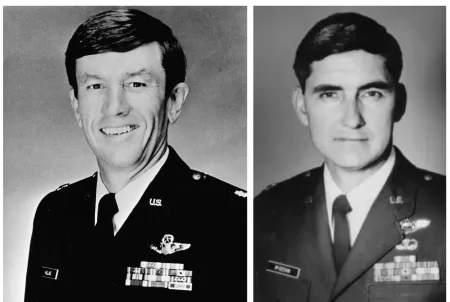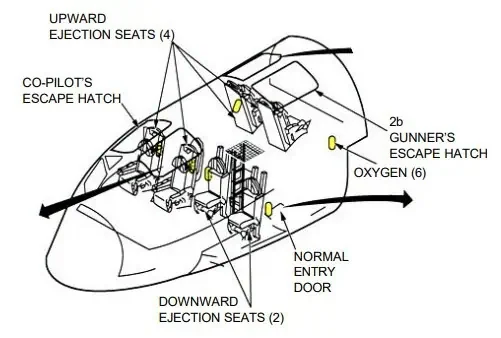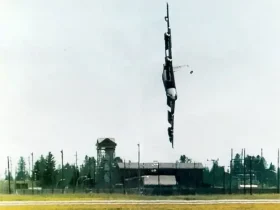The B-52 Stratofortress has remained the epitome of strategic bombing since its inception in the 1950s. This long-range bomber has the ability to obliterate an entire city in mere seconds, thanks to its wide array of armaments. Originally designed to carry nuclear weapons, the newest H model can carry 70,000 pounds of mixed ordinance, including Conventional Air Launched Missiles (CALMs) and bombs.
The Protagonist of the Story
In the history of the B-52, the Fairchild Air Force Base holds significance as it has hosted a B-52 wing since the arrival of the first B-52 Stratofortress in 1957. Conversely, the Fairchild Air Force Base was under spotlight due to major crashes involving the B-52s. The most prominent crash among them involved a B-52 commanded by Lieutenant Colonel Arthur Alan (“Bud”) Holland and Lieutenant Colonel Mark C. McGeehan, the commanding officer of the 325th Bomb Squadron. In addition to the two pilots, a radar navigator and a safety observer were onboard the bomber. On this day, June 24, 1994, the aircraft carrying the call sign Czar52 (serial number 61-0026) left the runway of Fairchild AFB for one last time!

The Fatal Timeline
The respective B-52H assigned to the 325th Bomb Squadron left the Fairchild AFB runway around 1358 Pacific Daylight Time (PDT). The intention of the flight was to practice maneuvers for an upcoming air show. The crew conducted the practice run uneventfully and prepared to land the bomber. It performed a go-around due to traffic on the runway, followed by a 360-degree turn around the control tower. At this time, the aircraft was very close to the ground, flying only 250 feet above ground level. During the turn, the aircraft banked left abruptly, making the bomber almost 90° vertical. The maximum bank angle allowed for the B-52H is 50°, although that could be performed at an altitude above 1000 feet. As the aircraft wasn’t designed for such aggressive maneuvers, it stalled at the steep bank angle and started plummeting towards the ground. Its left wing clipped a power line, giving out sparks, and the aircraft slammed onto the ground in the very next second, creating a huge fireball. The time of the crash was 1416 PDT, 18 minutes from takeoff. All four crew members were killed.

Champagne Dream Shattered
The safety observer, Colonel Robert Wolff, was the Vice Wing Commander of the 325th Bomb Squadron, and he was participating in his ‘fini flight’ or the last flight before his retirement. Woefully, Colonel Wolff’s wife, friends, and relatives were expecting him after the flight for a champagne toast to celebrate his retirement.
The Man Who Brought the Plane Down
Lt Col Holland had a distinguished reputation as one of the best B-52 pilots, having flown the bomber for more than 5,000 hours. This reputation made him a maverick. Despite his experience and fame in flying, junior aviators often criticized him for trying dangerous maneuvers on the B-52. Lt Col Holland breaching FAA regulations at the Fairchild air show by exceeding pitch and roll, dangerously flying low at Yakima bombing range, and a few other occasions were a prelude to the tragic event that happened in 1994. A crew member who had flown with Lt Col Holland commented that he had pitched up the bomber to 80°, making it almost vertical at the climb. It was popular among the AFB that he held a lifetime goal of rolling the behemoth B-52!
Major Thompson, the squadron operations officer who wasn’t comfortable flying with Lt Col Holland, once stated that,
“I had this fear that he was again going to get into the airshow . . . that he was going to try something again, ridiculous maybe and kill thousands of people.”
Here is another comment added by a crew member in 1994 amidst the growing concerns about Lt Col Holland’s behavior and the increasingly tense atmosphere at Fairchild Air Force Base:
“You could see it, hear it, feel it, and smell it coming. We were all just trying to be somewhere else when it happened.”
Deteriorating the Culture of Compliance
Despite being aware of his pattern of poor airmanship, which became apparent between 1991 and June 1994, and his routine violations of flight regulations, his superiors often praised his skills and experience. This favoritism of higher ranks overshadowed the critical necessity to address his reckless behavior and became the greatest hindrance to the culture of compliance within the Fairchild AFB. The ultimatum of breakdown in compliance culture cost a few hundred millions and four lives that cannot be valued by any means.
On the day of the accident, the same crew had flown a previous profile that closely resembled the one that led to the crash. The wing commander limited the bank angle to 45° and the pitch to 25°, even though these values already exceeded regulatory limits. To no one’s surprise, Lt Col Holland exercised his reckless flying, throwing the regulations to the wind. Yet, in the end, he received a clean bill of health from the AFB superiors.
What Actually Caused the Crash?
The tragedy of CZAR52 isn’t the result of one single action or one single person, but a chain of events that took place over several years. Usually, all the officers who openly criticized Holland’s behavior and demanded disciplinary action were overruled. That said, crew members got used to getting along with his actions. On the day of the accident, the bomber was very close to the ground, at an altitude of 250 feet. Yet, Holland attempted a knife-edge maneuver with this 185-foot wingspan aircraft. This maneuver stalled the aircraft and made it lose altitude. At the time of impact, the aircraft was at a bank angle of 95° and flying at a speed of 150 knots.
Why Did Not the Pilots Eject?
The answer is simple! The aircraft was so close to the ground that there was no room for the pilots to react. The B-52 has five crew stations, and all five stations are equipped with ejection seats. Each seat operates independently, while the pilot, co-pilot, and EWO sit on the upper deck and jettison upwards while the two navigators sit on the lower deck and jettison downwards. The co-pilot, Lt Col McGeehan, had fired his ejection seat, but the aircraft was too low and there wasn’t enough altitude to complete the ejection sequence. The below image shows that the escape hatch of the co-pilot has been jettisoned, but the pilot is still within the aircraft.


Aftermath of the Accident
During the investigation, it was identified that, during the accident flight, the pilots had violated altitude restrictions, bank angle restrictions, and air speed restrictions as stipulated in the flying manual. In addition, the investigation board identified that the wing seniors were reluctant to act against Lt Col Holland. Another contributing factor to this was the frequent switching of wing commanders at Fairchild AFB, which led to inconsistent oversight and enforcement of safety protocols. At the end of the investigations, the former Deputy Operations Commander, Col Pellerin, pleaded guilty to dereliction of duty for not taking necessary actions against Lt Col Holland amid the deluge of complaints received against his rogue airmanship.
Regardless of any means, the CZAR52 tragedy could have been avoided if the preventable issues had been addressed and corrected at their inception, highlighting the critical importance of strict adherence to safety regulations and proactive leadership in aviation. The CZAR52 crash has now been integrated into many study materials in both military and commercial aviation to highlight the necessity of adhering to safety protocols and maintaining a culture of conformity.



Leave a Reply